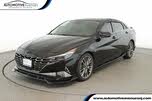2020 Hyundai Elantra vs 2021 Hyundai Elantra
Overview | ||
MSRP | $19,300 | $19,650 |
Average price | $13,993 | $17,238 |
Listings | ||
Ratings & Reviews | ||
User reviews | ||
Expert reviews | 8.3 out of 10Read full review | 8.8 out of 10Read full review |
Pros & cons | Pros
| Pros
|
Summary | Hyundai isn’t pulling any punches when it comes to the compact car segment, where value is of utmost importance. And though a completely redesigned 2021 Elantra is coming soon, the automaker bestows several value-enhancing improvements upon the outgoing 2020 Hyundai Elantra compact sedan. They include free scheduled maintenance, improved fuel economy ratings, and new standard safety features. | Compact cars are no longer compact. Cheap cars are no longer cheap. And it is no longer necessary to buy a luxury vehicle for performance, technology, and sophistication. The redesigned 2021 Hyundai Elantra proves it. |
Video | No video found | |
Popular Features & Specs | ||
Engine | 2.0L 147 hp I4 | 2.0L 147 hp I4 |
Drive Train | FWD | FWD |
Seating Capacity | 5 | 5 |
Horsepower | 147 hp @ 6200 rpm | 147 hp @ 6200 rpm |
MPG City | 31 | 31 |
MPG Highway | 41 | 41 |
Engine | ||
Engine Name | 2.0L 147 hp I4 | 2.0L 147 hp I4 |
Torque | 132 lb-ft @ 4500 rpm | 132 lb-ft @ 4500 rpm |
Horsepower | 147 hp @ 6200 rpm | 147 hp @ 6200 rpm |
Drivetrain | FWD | FWD |
Fuel Economy | ||
MPG City | 31 | 31 |
MPG Highway | 41 | 41 |
Interior | ||
Seating Capacity | 5 | 5 |
Safety | ||
Front Crash Overall | 4 | |
Side Crash Overall | 4 | |
Dimensions & Capacity | ||
Cargo Space | 14.4 cu ft | 14.2 cu ft |
Curb Weight | 2844 lbs | 2725 lbs |
Height | 56.5 in | 55.7 in |
Length | 181.9 in | 184.1 in |
Width | 70.9 in | 71.9 in |
Wheelbase | 106.3 in | 107.1 in |
Maximum Payload | 1080 lbs | 1133 lbs |
Number of doors | 4 | 4 |
The 2020 Hyundai Elantra, last redesigned in 2017 and restyled in 2019, maintained its visual look for 2020 without any changes. The 2019 restyle introduced a geometric-influenced appearance that served as a precursor to the 2021 model's more dramatic design shift. The 2020 line-up offered six different versions: SE, SEL, Value Edition, Eco, Limited, and Sport, with prices ranging from $19,300 to $24,150.
Our test model, the Elantra Limited, was decked out in black paint which contrasted strongly with its angular headlight, fog light, and wheel designs. This, combined with the chrome detailing on the grille, beltline, and logos, resulted in a stylish vehicle that might not appeal universally but certainly turned heads. The interior saw modest upscale enhancements with the addition of silver trims on various controls and the steering wheel. While these treatments added a dash of luxury, the pervasive hard and glossy plastics were a reminder that it remained a compact car.
The 2021 Hyundai Elantra, however, underwent an unmistakable transformation, embodying Hyundai’s new Sensuous Sportiness design language. Featuring sharp creases, dramatic angles, and a unique Z-shaped indentation on the car's doors, the 2021 model presented a bold and distinctive aesthetic.
Available in SE, SEL, N Line, and Limited trims, and also offering a hybrid powertrain for SEL and Limited, the prices ranged from $19,650 to $25,450 before destination charges. A notable high-performance Elantra N was expected to debut, adding a touch of racing inspiration to the mix.
Inside, the revamped Elantra boasted a driver-focused dashboard with an angled passenger cornering grip. Higher trims, like the Limited or Hybrid Limited in Gray, featured light gray seats, dash, and trim panels that contrasted with the predominantly black cabin. This setup helped conceal some of the cheaper plastics and lent the interior a modern, upscale vibe.
The 2020 Hyundai Elantra was powered by a 2.0-liter four-cylinder engine making 147 horsepower, paired with a brand-new continuously variable transmission (CVT). This CVT, enhancing efficiency with simulated gear shifts and chain belts, replaced the six-speed manual gearbox, contributing to a $1,100 price increase from the previous year. The Elantra was exclusively front-wheel drive.
Specialty models included the Elantra Eco, featuring a turbocharged 1.4-liter four-cylinder engine producing 128 horsepower, paired with a seven-speed dual-clutch automatic transmission (DCT) and an auto start/stop system. This model delivered 36 mpg in combined driving, bettering the standard powertrain’s 34 mpg.
The Elantra Sport, with a 1.6-liter turbo four-cylinder engine generating 201 horsepower and 195 lb-ft of torque, offered a sportier ride thanks to its independent rear suspension. Despite these advantages, it regrettably lost its manual gearbox in favor of a seven-speed DCT for the 2020 model.
Our test Elantra Limited, equipped with the standard 2.0-liter engine and CVT, delivered a commendable performance, though real-world fuel efficiency lagged behind expectations, averaging 29.3 mpg instead of the EPA-rated 34 mpg. The simple torsion beam axle rear suspension led to a less refined ride, particularly on uneven road surfaces, though it retained acceptable handling for everyday commutes.
The 2021 Hyundai Elantra, reviewed extensively over hundreds of miles, offered a variety of powertrains. The standard engine was a 2.0-liter four-cylinder producing 147 horsepower and 132 lb-ft of torque, paired with a chain-type variator CVT that provided a responsive and smooth drive. Despite EPA ratings of 35 mpg in combined driving, our test car achieved only 31.4 mpg.
The Hybrid Limited model featured a 1.6-liter Atkinson-cycle four-cylinder engine with an electric motor, achieving a combined output of 139 horsepower via a six-speed DCT. Though it boasted an EPA rating of 50 mpg, our test yielded 42.2 mpg, possibly impacted by mountainous terrain.
The performance-oriented Elantra N Line, replacing the Sport trim, used a turbocharged 1.6-liter four-cylinder engine with 201 horsepower and 195 lb-ft of torque. With a manual gearbox option and enhanced suspension and braking systems, this model was a joy to drive, albeit with a lower fuel economy of 23.1 mpg in mountain driving.
Lastly, the Elantra N, sporting a turbocharged 2.0-liter engine producing 276 horsepower and 289 lb-ft of torque, provided a thrilling ride with its electronically controlled suspension and performance-tuned components. It averaged 19.4 mpg and offered customizable driving modes to optimize various performance parameters.
The 2020 Elantra was praised for its roomy interior, comfortably accommodating four adults, with a bit of a squeeze for a fifth passenger over short distances. The Limited trim added luxury touches like power driver’s seat adjustment, leather upholstery, and a sliding center console armrest, enhancing comfort.
A dual-zone automatic climate control system came standard, though rear passengers lacked dedicated air conditioning vents. Storage solutions were practical for a compact car, with a trunk capacity of 14.4 cubic feet, nearly matching some midsize sedans. A practical grab handle inside the trunk lid facilitated easy closure.
Redesigned for 2021, the new Elantra gained classification as a midsize car by the EPA, offering ample cabin space. Though front seats remained height-adjustable, the passenger seat lost this feature, and the use of hard upper door plastics persisted.
Rear legroom was class-leading, offering generous foot space and a high bottom cushion for leg support. The backrest design, however, was less supportive for upper backs, and rear-seat passengers still missed out on air conditioning vents and USB ports.
Storage continued to be practical, with the trunk offering 14.2 cubic feet of space and the convenience of a 60/40-split folding rear seat. The hands-free trunk lid became a noteworthy inclusion in certain trims.
For 2020, the Elantra equipped all trims with a touchscreen infotainment system with Bluetooth and a USB port. SE trims featured a 5-inch screen, while SEL and higher trims got a 7-inch display supporting Apple CarPlay, Android Auto, and SiriusXM satellite radio. Limited trims added wireless smartphone charging and an upgraded Infinity sound system, with the Ultimate Package providing an 8-inch screen with navigation.
The infotainment system was user-friendly, positioned conveniently at the top of the dashboard, with shortcut buttons and control knobs enhancing ease of use. The Infinity sound system impressed with its sound quality, uncommon for a compact car.
The 2021 Elantra shifted to a more advanced tech setup, with an 8-inch touchscreen standard on SE, SEL, and N Line trims. This system included wireless Apple CarPlay and Android Auto, satellite radio, and Blue Link connected services. N Line trims also featured wireless smartphone charging.
Limited trims took a step further with a dual 10.25-inch screen setup for both infotainment and digital instrumentation, similar to luxury brands like Mercedes-Benz. This upgrade included dynamic voice recognition, navigation, and a 64-color ambient lighting system but sacrificed wireless smartphone integration.
A new Bose premium sound system offered high audio quality, while the Hyundai Digital Key turned Android phones into digital car keys, enhancing convenience with temporary access and function restriction options.
For 2020, Hyundai made Smart Sense standard on all Elantra trims. This suite included forward collision warning, automatic emergency braking, lane departure warning, lane-keeping assist, and a driver attention monitor. Starting with SEL trim, blind-spot warning and rear cross-traffic alert were also included. Limited and Sport trims boasted full LED headlights with automatic high-beam operation. The Ultimate Package added adaptive cruise control and pedestrian detection.
The 2020 Elantra earned a Top Safety Pick from the IIHS with LED headlights, but a four-star overall rating from the NHTSA, which flagged concerns about rear-door intrusion during side-impact tests.
The 2021 Elantra introduced a new platform with enhanced structural integrity to better manage collision energy. Every trim level came with SmartSense, featuring forward collision warning with pedestrian detection, automatic emergency braking, lane-departure warning, lane-keeping assistance, lane-centering assistance, automatic high-beam headlights, and a driver attention warning system.
Additionally, all trims included blind-spot warning and rear cross-traffic warning systems, a Rear Occupant Alert system, and Safe Exit Warning. Higher trims offered cyclist detection, junction turning assistance, adaptive cruise control, rear automatic braking, and the advanced Highway Drive Assist, enhancing the Elantra’s safety offerings.
CarGurus highlights

According to CarGurus experts, the overall rating for the 2020 Hyundai Elantra is 8.3 out of 10, while the 2021 Hyundai Elantra scores 8.8 out of 10. With higher ratings for its advanced technology, improved safety features, and striking design, the 2021 Hyundai Elantra stands out as the superior choice. For those seeking a state-of-the-art compact sedan with impressive features and a distinctive style, the 2021 model is the clear winner.
Choose the 2020 Hyundai Elantra if:
Shop Now- Budget Sensibility: You’d prefer a slight cost-saving on the initial vehicle price.
- Proven Design: You like the familiarity and established aesthetic of Hyundai’s previous design language.
- Available in Hatchback: You want the option of an Elantra GT hatchback for additional cargo room.
Choose the 2021 Hyundai Elantra if:
Shop Now- Modern Design: You appreciate the bold, modern styling and parametric details of the latest model.
- Advanced Technology: You want the latest infotainment tech, including larger screens and better integration.
- Superior Fuel Efficiency: You seek the hybrid option for better fuel economy and quick electric motor torque.

By: CarGurus + AI
At CarGurus, our team of experienced automotive writers remain at the heart of our content operation, conducting hands-on car tests and writing insightful guides that are backed by years of industry experience. To complement this, we are harnessing AI to make our content offering more diverse and more helpful to shoppers than ever. To achieve this, our AI systems are based exclusively on CarGurus content, ratings and data, so that what we produce is both unique to CarGurus, and uniquely helpful to car shoppers.
































